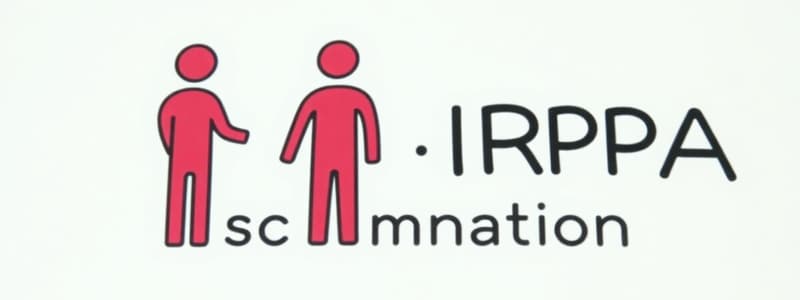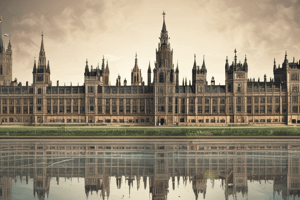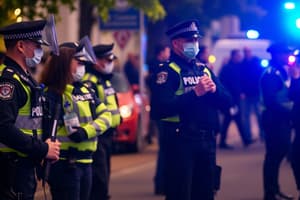Podcast
Questions and Answers
What is systemic discrimination often also called?
What is systemic discrimination often also called?
- Overt discrimination
- Institutional discrimination (correct)
- Direct discrimination
- Implicit discrimination
Which of the following best describes the impact of informal mentoring on employees with disabilities?
Which of the following best describes the impact of informal mentoring on employees with disabilities?
- It reduces the need for performance evaluations.
- It may disadvantage those unable to participate after hours. (correct)
- It provides equal opportunities for promotion.
- It helps all employees build networks equally.
How is systemic discrimination typically identified?
How is systemic discrimination typically identified?
- By reviewing company policies in isolation.
- Through qualitative surveys on employee satisfaction.
- Through anecdotal evidence from employees.
- By comparing numerical data and representation. (correct)
Which statement about human rights legislation is incorrect?
Which statement about human rights legislation is incorrect?
What is a potential consequence of systemic discrimination regarding performance evaluations?
What is a potential consequence of systemic discrimination regarding performance evaluations?
What is the primary purpose of the Individual's Rights Protection Act (IRPA) in Alberta?
What is the primary purpose of the Individual's Rights Protection Act (IRPA) in Alberta?
Which of these grounds is NOT specifically prohibited from discrimination under the Alberta Human Rights Act?
Which of these grounds is NOT specifically prohibited from discrimination under the Alberta Human Rights Act?
How did the Alberta Bill of Rights influence human rights legislation?
How did the Alberta Bill of Rights influence human rights legislation?
When was the latest version of British Columbia's Human Rights Code enacted?
When was the latest version of British Columbia's Human Rights Code enacted?
What significant function does a human rights commission serve under the IRPA?
What significant function does a human rights commission serve under the IRPA?
What distinguishes human rights legislation in Alberta from the Canadian Charter of Rights and Freedoms?
What distinguishes human rights legislation in Alberta from the Canadian Charter of Rights and Freedoms?
What is meant by the term 'primacy legislation' as it relates to the IRPA?
What is meant by the term 'primacy legislation' as it relates to the IRPA?
Which of the following statements about the scope of human rights law is true?
Which of the following statements about the scope of human rights law is true?
What does the term 'trans' encompass?
What does the term 'trans' encompass?
What defines a transsexual person?
What defines a transsexual person?
What aspect does gender expression include?
What aspect does gender expression include?
How did the BC government address calls for greater inclusion of transgender individuals in 2016?
How did the BC government address calls for greater inclusion of transgender individuals in 2016?
How is gender identity described in the content?
How is gender identity described in the content?
What was significant about the case Nelson v Goodberry Restaurant Group Ltd?
What was significant about the case Nelson v Goodberry Restaurant Group Ltd?
Which components are part of a person's gender identity?
Which components are part of a person's gender identity?
What does the BC Tribunal's definition of gender expression imply?
What does the BC Tribunal's definition of gender expression imply?
What does the BC Code prohibit employers from doing regarding a person's criminal record?
What does the BC Code prohibit employers from doing regarding a person's criminal record?
Which of the following scenarios could lead to a discrimination claim under the BC Code?
Which of the following scenarios could lead to a discrimination claim under the BC Code?
What is the stance of the BC Court of Appeal on preserving the employment status of employees serving prison sentences?
What is the stance of the BC Court of Appeal on preserving the employment status of employees serving prison sentences?
In the context of the BC Code, what is the rationale behind protecting individuals with criminal records?
In the context of the BC Code, what is the rationale behind protecting individuals with criminal records?
Which of the following grounds is not recognized for discrimination under the Alberta Act?
Which of the following grounds is not recognized for discrimination under the Alberta Act?
What is a potential legal term referenced regarding the BC Court of Appeal's decision on maintaining employment status?
What is a potential legal term referenced regarding the BC Court of Appeal's decision on maintaining employment status?
Which statement best summarizes the employment protection provided by the BC Code regarding criminal records?
Which statement best summarizes the employment protection provided by the BC Code regarding criminal records?
What is one exception noted in the BC Code for discrimination regarding criminal records?
What is one exception noted in the BC Code for discrimination regarding criminal records?
What is required for an employer to meet the third part of the Meiorin test?
What is required for an employer to meet the third part of the Meiorin test?
According to the Supreme Court of Canada's 2008 Hydro-Québec decision, what did the Court clarify about the Meiorin test?
According to the Supreme Court of Canada's 2008 Hydro-Québec decision, what did the Court clarify about the Meiorin test?
What aspect must employers consider when setting a standard or rule?
What aspect must employers consider when setting a standard or rule?
What does the high standard for the third part of the Meiorin test require from employers?
What does the high standard for the third part of the Meiorin test require from employers?
What should employers investigate as an alternative approach to standards?
What should employers investigate as an alternative approach to standards?
What constitutes undue hardship for an employer?
What constitutes undue hardship for an employer?
Which of the following factors should be considered when assessing if the duty to accommodate has been met?
Which of the following factors should be considered when assessing if the duty to accommodate has been met?
How should legitimate workplace objectives be approached according to the content?
How should legitimate workplace objectives be approached according to the content?
What was the initial amount Francis sought for damages due to discrimination?
What was the initial amount Francis sought for damages due to discrimination?
What percentage discount was applied to Francis' damages award?
What percentage discount was applied to Francis' damages award?
How much was the final award for injury to dignity after the discount was applied?
How much was the final award for injury to dignity after the discount was applied?
Besides the injury to dignity award, what other type of compensation did Francis receive?
Besides the injury to dignity award, what other type of compensation did Francis receive?
Why was Francis considered particularly vulnerable in his workplace situation?
Why was Francis considered particularly vulnerable in his workplace situation?
What major mental health disorders was Francis diagnosed with?
What major mental health disorders was Francis diagnosed with?
Which of the following was NOT a factor considered by the BC Tribunal when awarding damages?
Which of the following was NOT a factor considered by the BC Tribunal when awarding damages?
What was the BC Tribunal's stance on significant injury to dignity awards?
What was the BC Tribunal's stance on significant injury to dignity awards?
Flashcards
Systemic Discrimination
Systemic Discrimination
A type of discrimination where policies or practices, seemingly neutral, negatively impact certain groups.
Neutral on their face
Neutral on their face
Policies or practices that appear neutral but have a discriminatory impact on specific groups.
Numerical data
Numerical data
Analyzing data to identify patterns of discrimination. For instance, if a company has fewer women in leadership roles compared to the overall workforce.
Human Rights Legislation
Human Rights Legislation
Signup and view all the flashcards
Charter vs Human Rights Legislation
Charter vs Human Rights Legislation
Signup and view all the flashcards
Application of Human Rights Legislation
Application of Human Rights Legislation
Signup and view all the flashcards
Workplace Discrimination and Harassment
Workplace Discrimination and Harassment
Signup and view all the flashcards
Initial Focus of IRPA
Initial Focus of IRPA
Signup and view all the flashcards
Prohibited Grounds of Discrimination in Alberta
Prohibited Grounds of Discrimination in Alberta
Signup and view all the flashcards
Primacy Legislation
Primacy Legislation
Signup and view all the flashcards
Alberta Act as Primacy Legislation
Alberta Act as Primacy Legislation
Signup and view all the flashcards
BC Human Rights Code History
BC Human Rights Code History
Signup and view all the flashcards
Role of Human Rights Commission
Role of Human Rights Commission
Signup and view all the flashcards
Gender Identity
Gender Identity
Signup and view all the flashcards
Gender Expression
Gender Expression
Signup and view all the flashcards
Transgender
Transgender
Signup and view all the flashcards
Transsexual
Transsexual
Signup and view all the flashcards
Protection Against Discrimination
Protection Against Discrimination
Signup and view all the flashcards
Nelson v Goodberry Restaurant Group Ltd
Nelson v Goodberry Restaurant Group Ltd
Signup and view all the flashcards
Human Rights Tribunal Process
Human Rights Tribunal Process
Signup and view all the flashcards
Legal Definitions of Gender Identity and Expression
Legal Definitions of Gender Identity and Expression
Signup and view all the flashcards
Sexual Orientation Discrimination in BC
Sexual Orientation Discrimination in BC
Signup and view all the flashcards
Criminal Record and Employment in BC
Criminal Record and Employment in BC
Signup and view all the flashcards
Employment During Incarceration in BC
Employment During Incarceration in BC
Signup and view all the flashcards
BC Court Decision on Incarceration and Employment
BC Court Decision on Incarceration and Employment
Signup and view all the flashcards
Criminal Record Discrimination in Alberta
Criminal Record Discrimination in Alberta
Signup and view all the flashcards
Using Criminal Records in BC Hiring
Using Criminal Records in BC Hiring
Signup and view all the flashcards
BFOR Defense in BC Human Rights
BFOR Defense in BC Human Rights
Signup and view all the flashcards
Burden of Proof for BFOR
Burden of Proof for BFOR
Signup and view all the flashcards
Injury to Dignity Damages
Injury to Dignity Damages
Signup and view all the flashcards
Wage Loss and Pension Loss Damages
Wage Loss and Pension Loss Damages
Signup and view all the flashcards
Contingency Factor
Contingency Factor
Signup and view all the flashcards
Damages Discount
Damages Discount
Signup and view all the flashcards
Extreme Injury
Extreme Injury
Signup and view all the flashcards
Hostile Work Environment
Hostile Work Environment
Signup and view all the flashcards
Significant Injury to Dignity Award
Significant Injury to Dignity Award
Signup and view all the flashcards
Discrimination Tribunal
Discrimination Tribunal
Signup and view all the flashcards
Meiorin Test (3 parts)
Meiorin Test (3 parts)
Signup and view all the flashcards
Undue Hardship (Meiorin Test)
Undue Hardship (Meiorin Test)
Signup and view all the flashcards
Third Part of Meiorin Test
Third Part of Meiorin Test
Signup and view all the flashcards
Accommodating for Differences
Accommodating for Differences
Signup and view all the flashcards
Alternative Approaches
Alternative Approaches
Signup and view all the flashcards
Reasons for Not Implementing Alternatives
Reasons for Not Implementing Alternatives
Signup and view all the flashcards
Validating the Standard
Validating the Standard
Signup and view all the flashcards
Less Discriminatory Methods
Less Discriminatory Methods
Signup and view all the flashcards
Study Notes
Learning Outcomes
- Explain discrimination, under the British Columbia Human Rights Code and the Alberta Human Rights Act.
- Identify features of the statutes, including prohibited grounds and areas of discrimination.
- Understand "equal pay for equal work" and "employment equity".
- Outline remedies available for complainants.
- Detail human rights issues in hiring, including job ads, applications, and interviews.
- Understand pre-employment testing, especially medical and drug/alcohol testing.
- Identify implications of human rights legislation during employment, including the duty to accommodate.
Understanding Discrimination and Human Rights Complaints
- Discrimination was once legal in Canada.
- Human rights legislation now prohibits discrimination in employment, services, and accommodation.
- Human rights are a key factor throughout employment.
- Alberta and BC legislation require employers to maintain discrimination- and harassment-free workplaces.
- Human rights laws apply to individuals and corporations.
What Constitutes Discrimination?
- Discrimination is not explicitly defined in the Alberta Act or BC Code.
- The courts have addressed discrimination, including intentional and unintentional actions.
- A three-part test establishes discrimination: protected characteristic, adverse impact, and the protected characteristic being a factor in the adverse impact.
- The employer must justify policies, practices, or conduct if a discrimination claim is made.
Key Features of Human Rights Legislation
- Applies to both public and private sectors and individuals.
- Prohibits discrimination on multiple grounds (similar but not identical in Alberta and BC).
- Duty to accommodate exists, unless undue hardship for employer.
Prohibited Grounds of Discrimination in Employment
- Alberta and BC prohibit discrimination based on grounds including: race, religion, colour, gender, age, ancestry, place of origin, marital status, family status, sexual orientation, physical disabilities, mental disabilities, etc.).
- Both statutes include some exceptions (if the reason is a Bona Fide Occupational Requirement).
- "Systemic discrimination" is when neutral policies/practices have a discriminatory effect.
Overview of Alberta's and British Columbia's Human Rights Legislation
- The legislation seeks respect, dignity, and equality for all.
- The Alberta Bill of Rights protected against government abuse.
- The IRPA, in Alberta, specifically outlawed discrimination.
- The BC Code came into force in 2018, preventing discrimination on 15 grounds, similar to Alberta.
What Constitutes Discrimination?
- The term discrimination is not defined in the statutes but courts have detailed a three-part test to determine when discrimination has occurred.
- Systemic discrimination is a subtle form where policies/practices have a discriminatory outcome.
Key Features of Human Rights Legislation
- The scope of human rights is interpreted quite liberally.
- Courts and tribunals generally apply remedial legislation, seeking to remedy discrimination.
- The law prioritizes conciliation and compensation over criminal penalties.
Studying That Suits You
Use AI to generate personalized quizzes and flashcards to suit your learning preferences.




